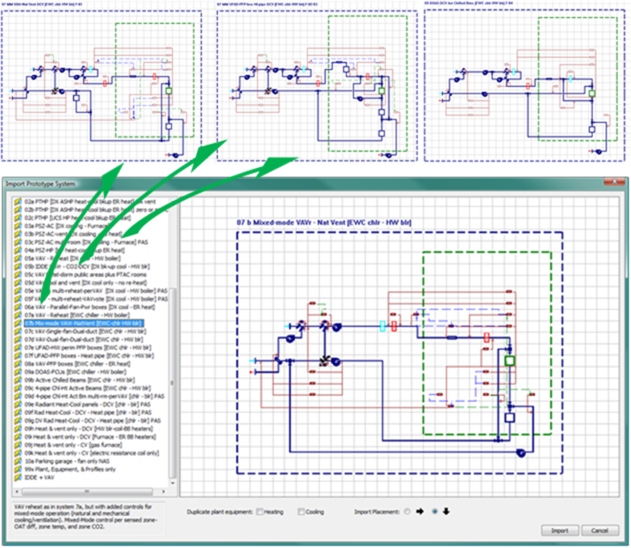1.2.1 Zone-level system set up and autosizing steps
Unless the model has exceptionally small number of thermal zones, conditioned spaces or thermal zones in model should first be according to system or air-handler assignment. If using the System Prototypes & Sizing navigator, prepare for the sizing process by loading the blank (default) Loads Data spreadsheet into the project folder via the Acquire prototype data action in the navigator. As of version 6.5, this will be automatically loaded when using the system parameters and sizing toolbar buttons within ApacheHVAC.
Having completed these preparations, the main steps in system setup and autosizing are as follows:
 Figure 9-2: Open ApacheHVAC, load selected systems from the HVAC Prototype Systems Library as needed, and save the file. When using workflow navigators for either the ASHRAE 90.1 PRM or System Prototypes & Sizing, creation and naming of a blank file called “proposed.asp” is automatically executed by the Prototype System action in the navigator; however, outside the context of the ASHRAE 90.1 PRM Navigator, this naming is not required when working directly from the ApacheHVAC toolbar.
Figure 9-2: Open ApacheHVAC, load selected systems from the HVAC Prototype Systems Library as needed, and save the file. When using workflow navigators for either the ASHRAE 90.1 PRM or System Prototypes & Sizing, creation and naming of a blank file called “proposed.asp” is automatically executed by the Prototype System action in the navigator; however, outside the context of the ASHRAE 90.1 PRM Navigator, this naming is not required when working directly from the ApacheHVAC toolbar. Additional systems can be loaded at any time and additional sizing runs performed as needed. Prototype systems can be modified or used as resources from which to copy elements for customizing or extending the capabilities of a particular system. For all but advanced users, however, it is recommended that initial system sizing and brief test simulations are completed prior to modifying the system configuration, components, or controls (substantial experience with ApacheHVAC is also recommended).
As noted above, when using the workflow navigators, the automated zone-level sizing procedure requires that the target ApacheHVAC system file is named “proposed.asp”. This file name must be in place prior to using either System Parameters or Room Load Calculations in either the System Prototypes & Sizing navigator or the ASHRAE 90.1 PRM navigator. The target system name “proposed.asp” must also remain in place (or be reinstated) for the Assign system parameters and room sizing data action in the sizing navigator. The ApacheHVAC file name can be subsequently changed without consequence. This naming convention is not required for the System-level loads and sizing process described below or when working directly from the Systems setup and sizing toolbar in ApacheHVAC.
Figure 9-3: Use Edit Multiplex to assign groups of rooms or zones to the prototype system.
Figure 9-4: System Schedules dialog edits coordinated profiles used in system controllers and Space Data.
Figure 9-5: Opening the System Parameters dialog generates a Loads Data spreadsheet for each system (one per multi-zone system or set of single-zone systems) and provides access to setting essential parameters for system sizing and operation via the spreadsheets.* Edited parameters are recorded in the respective Loads Data spreadsheet for use in subsequent steps of the process—i.e., edits to these parameters are not immediately reflected in the ApacheHVAC system components and controllers.
*Note: In 2013 detailed system parameter dialogs with tabular edit views will be attached to each system and the Loads Data spreadsheet will no longer be used.
Figure 9-6: The Room Load Calculations step in the System Prototypes & Sizing navigator runs ASHRAE Loads and populates the Loads Data spreadsheet for each network with loads results and other relevant data, such as room volumes. Calculations for zone airflows and similar parameters use the loads data and previously recorded settings from the System Parameters dialog. There are optional features in the spreadsheet for zone-specific airflow configurations and calculation of ASHRAE 62.1 ventilation rates.
Figure 9-7: The Assign System Parameters and Room Sizing Data step assigns values to system components and controllers. This is the essential final step in the zone-level autosizing. Viewing the zone heating or cooling airflow rates for all multiplex layers confirms that this stage of autosizing is complete.